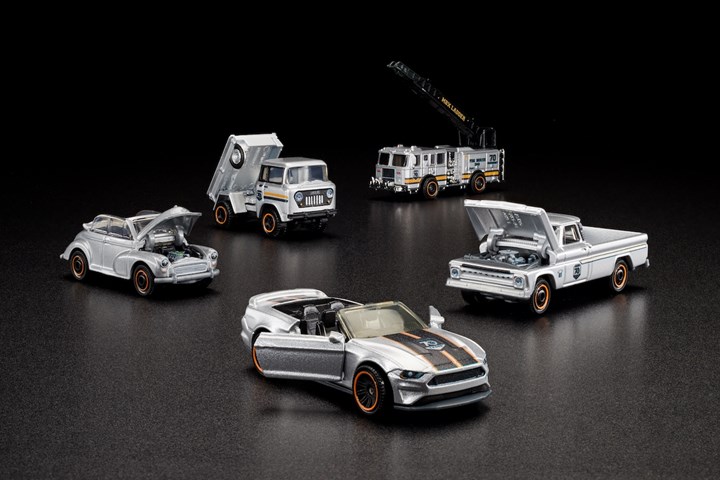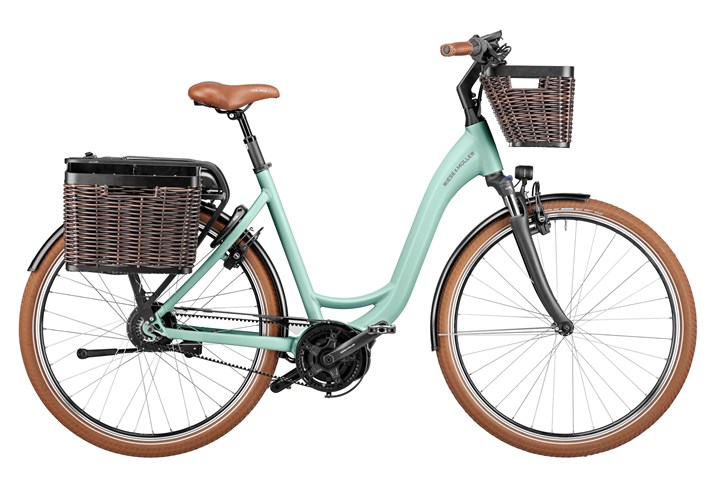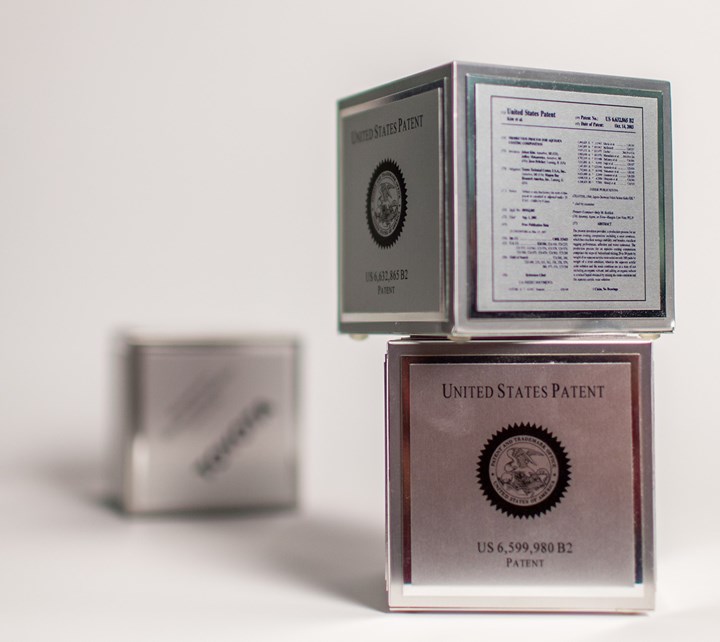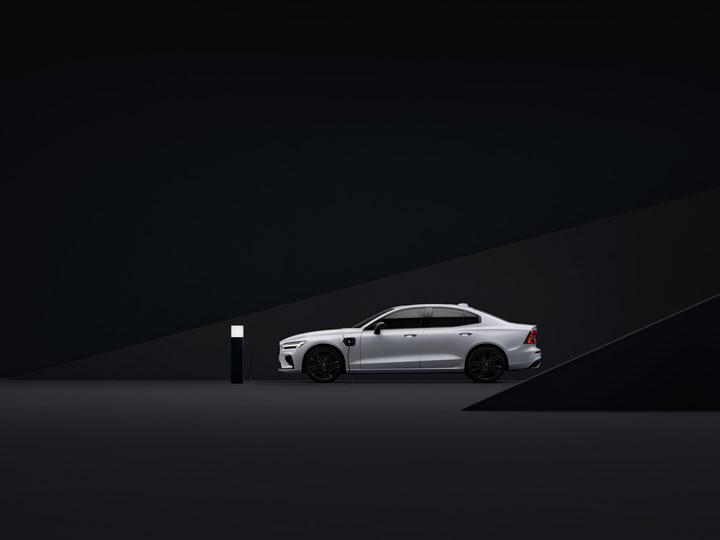on Casting, Hydrogen, the Future, Mobility, Bikes, & More
Tesla and Matchbox. . .hydrogen for trains. . .Ford looks at the future. . .mobility for the disabled. . .stealing bikes in Amsterdam. . .Toyota racks up the patents. . .Volvo S60 reviewed. . .
Advances in Casting

Tesla may be casting large portions of its vehicles, but Matchbox does the whole thing. (Image: Mattel)
Massive aluminum diecast components—produced by “giga presses”—have become an increasingly important part of chassis engineering. . .thanks, of course, to Tesla, which has been using the equipment (which it sources from Italian company IDRA Group) for the past few years. It now has about a dozen of the diecasting machines, including a recently installed 9,000-ton machine at its plant in Austin for the Cybertruck.
By making large chassis components in a single pieces (e.g., front; rear), the amount of stamping, welding, material handling, etc. is greatly reduced.
As Tesla put it in its Q2 2022 Investor Deck:
“The architecture of electric vehicles allows us to rethink vehicle design and the manufacturing process beyond what was possible in the combustion engine era. Thanks to large castings and parts consolidation, the robot count in our body shops in new factories dropped by over 70% per unit of capacity compared to our first iteration of Model 3 Body Shop. Our quest for simplification is not over. We will continue to drive simplification further with every new product and every new factory.”
Not exactly encouraging for robot manufacturers.
Big & Small
Other OEMs are going the casting route, too.
The Cadillac CELESTIQ, for example, will have an underbody consisting of six sand-cast aluminum components that are called “Mega Castings.” Each single casting will reduce part count by 30 to 40 components.
Which brings us to the 70th anniversary of something closely associated with automotive diecasting:
Matchbox vehicles.
They’ve been using the process to produce all manner of diminutive vehicles since 1953.
Roberto Stanichi, Senior Vice President, Global Head of Vehicles at Mattel, said, “We look forward to continuing to redefine the diecast category as we move towards a more sustainable future.”
Presumably this refinement won’t have any giga casting aspects to it. But it is interesting to note that last year Matchbox produced its first diecast car that was made from 99% recycled materials and certified CarbonNeutral: a Tesla Roadster.
The 70th anniversary vehicles are being made with a recycled zinc alloy.
Matchbox?
Back in 1953 Jack Odell, an engineer in the U.K., developed a toy for his daughter to bring to school: It had to be small enough to fit into a match box.
Turned out that many of the other kids wanted one of their own, which gave rise to the company.
The vehicle Odell made for his daughter was. . .a diecast steam roller.
///Hydrogen Riding the Rails

Type 4 high-pressure hydrogen tank. (Image: Hexagon Purus)
Deutsche Bahn (DB) is the leading railway operator in Europe. (It also provides other types of mobility and logistics services that don’t necessarily ride on rails.)
The company intends to become climate neutral by 2040.
It will replace all of its diesel powered vehicles.
And one of the replacement fuels: hydrogen.
DB ordered mobile hydrogen refueling stations and stationary storage equipment from Hexagon Purus valued at 2.5-million €. It will be used for rail and other applications in Germany.
The hydrogen equipment will be delivered from Q2 to Q4 2023, so clearly DB’s carbon-neutral efforts are underway.
It is worth noting that diesel-electric railcars have been in use in Germany for more than 100 years, so this transition to an alternative is happening comparatively quickly.
///
What Do Drivers Want? Ford Has Some Answers

While this photo seems just to be a long shot from the back of an F-150, what it shows is that the front seats recline like those in executive class on a jet flying internationally. However, Ford research has found that on a global basis, only 9% nap in their vehicles. Come to think of it, that is a non-trivial number. (Image: Ford)
Ford has been doing global trends reports since 2013.
The most recent, “Further With Ford, 2023,” like its predecessors, looks at issues and concerns well beyond cars, including economics, psychology, sustainability, and more.
Still, the auto related responses are rather fascinating.
“I find joy in driving my car.”
55% of those in the U.S. say that.
But that’s not the highest number.
60% of those in both France and Germany agree.
64% in Mexico.
68% in South Africa.
==
One of the things that seems to be an increasingly important feature in vehicles is the audio system.
Yet one wonders how much of an edge that really is.
“I find joy in listening to music in my car”
- 54% of Gen Z say yes
- 55% of Millennials
- 51% of Gen X
- 47% of Boomers
Not exactly resounding support for adding that pricey audio.
==
You often see ads, especially for youth-oriented vehicles, showing lots of people in the vehicle, all ostensibly having fun.
“I find joy in spending time in my car with others”
- 30% of Gen Z agree
- 26% of Millennials
- 23% of Gen X
- 21% of Boomers
Much fewer than the supporters of audio.
==
There is the issue of personalization, of one’s vehicle being one’s own space.
“I find joy in being able to make my car my own space”
- 30% of Gen Z say yes
- 27% of Millennials
- 23% of Gen X
- 17% of Boomers
Which seems to go to the point that vehicles are largely a means of transportation rather than a rec room on vehicles.
This is underscored by another finding. Here we’ll look at the aggregate of all adults.
“I use my vehicle to. . .”
- 67% go places
- 30% have fun
- 27% relax
- 21% be alone
- 18% decompress
- 9% nap
Seems that transportation is the still the primary function.
Methodology?
Jennifer Brace, Trends and Futuring Manager at Ford, who led the study, explained to the Society of Automotive Analysts that there were 16,120 online interviews conducted across 16 countries (Australia, Brazil, Canada, China, France, Germany, India, Italy, Mexico, Saudi Arabia, South Africa, Spain, Thailand, United Arab Emirates, United Kingdom, and the United States).
///
Advancing Mobility for the Disabled
One of the aspects of “mobility” that doesn’t get a sufficient amount of attention is how it can benefit disabled individuals.
Last year Motability, a U.K.-based national charity, did a study in which it found that in the U.K.:
- 1 in 5 disabled people couldn’t travel due to appropriate transport options
- 40% had difficulties or issues while traveling by train in the U.K.
- A commute by a person in a wheelchair in London can take up to 5x longer than a non-disabled person
- 1 in 4 disabled people say negative attitudes expressed by other passengers prevent them from using public transport
- 30% of the disabled say difficulties with public transport reduce their independence
- 25% of working age disabled people say inaccessible transportation is a key barrier to employment
And there are more. Not exactly encouraging.
Examining Accessibility
Last week Coventry University in the U.K. announced the launch of the National Centre for Accessible Transport (NCAT). Its purpose is to improve accessibility to all types of transport.
NCAT is funded by Motability. It is a £20 million project.
NCAT will be based at the university’s National Transport Design Centre (NTDC) and will use the user-centered design approach developed at NTDC. It includes deeply involving the people for whom development is being done in the process, in this case the disabled.
Professor Paul Herriotts, who will head NCAT:
“It is vital that we listen to what disabled people have to say about their experiences of public and private transport and use this information to change the future of travel. NCAT will use research and insights to influence key decision makers in the transport sector and local and national government to ensure that the way disabled people travel and get from one place to another is made much easier.”
Motability also found that disabled persons in the U.K. make 38% fewer journeys than the non-disabled.
While technology can’t address all of the issues, presumably it can be a lever for facilitating transportation for people whether they live in London or Los Angeles, Coventry or Cincinnati.
///Bicycle Thieves

A bicycle by Reese and Muller. Style meets utility. Bikes like this undoubtedly contribute to the huge number of riders in the Netherlands. (Image: Reese and Muller)
- 11,000, say the reports
- 28,500, estimates the city
- 80,000, believe the advocates
One of those numbers—or something like them—is the number of bicycles stolen in Amsterdam each year.
Yes, there are a lot of bikes there—some 850,000—but still, that’s a lot of larceny.
Where Do They Go?
What happens to the stolen bikes?
MIT researchers, working with the Amsterdam Institute for Advanced Metropolitan Solutions, wanted to know, so they fitted a fleet of bikes with trackers.
Fabio Duarte, principal research scientist at MIT’s Senseable City Lab and co-author of a new paper detailing the experiment’s results:
“We thought bikes might be stolen and sent abroad. We found they are used in the same [locations]. If they’re stolen and sold, the new owner uses the bike in the same areas, probably without knowing it was stolen. There are so many bikes in Amsterdam, you’re likely never going to know it was yours.”
The paper, “Tracking Stolen Bikes in Amsterdam,” will be published in PLOS ONE.
The Stolen Bikes
70 bikes were stolen.
68 stayed in the local area.
12 were taken to locations that are known for black market bike sales.
22 had similar travel patterns so the researchers speculate they are part of a sub-network of bikes.
In a city with such a massive demand for two-wheel mobility, it seems that there’s little need for an international ring of bicycle thieves.
How Many Bikes?
According to the Discerning Cyclist, the Netherland has the greatest number of bicycles per capita: a population of 16,652,800 and 16,500,000 bikes, or 0.99 bikes per person.
To put that into context, according to a technical report produced last year by the Netherlands Institute for Transport Policy Analysis, “The Widespread Car Ownership in the Netherlands,” “As of early 2020, the Netherlands had 8.7 million cars owned by private individuals and companies.”
Yes, a lot of bikes.
///R&D Matters

Toyota is stacking up a lot of patents—more than any other OEM of late. (Image: Toyota)
What do these companies have in common?
- Samsung
- IBM
- LG
- Toyota
- Canon
- TSMC
- Huawei
- BOE Technology
- Raytheon
- Qualcomm
They are, in that order, the top 10 companies that received patents from the U.S. Patent Office in 2022, according to the Intellectual Property Owners Association.
With Toyota at number 4, the question becomes: Where are other vehicle manufacturers?
Next on the list is Hyundai. It is at 19.
Honda is 25 and Ford is 27.
Then it is all the way to 57: General Motors.
Porsche is at 69.
And that’s it for vehicle manufacturers in the top 100 of the IPO list.
There is another consideration.
The number of 2022 patents relative to the number in 2021.
- Toyota: +11%
- Hyundai: +20%
- Honda: +11%
- Ford: -20%
- GM: -3%
- Porsche: -8%
While there could be an argument made that application trumps research for commercial companies, when you look at just those top 10 companies it is evident that there is a recognition that R&D is a valuable lever.
This is remarkable:
Toyota claims that all-in, it spends more than $1-million per hour on R&D.
///S60 Recharge eAWD Black Edition

S60 Black Edition: plug-in hybrid with an edge. (Image: Volvo)
“The design of the S60 Black Edition evokes a passionate response across the company,” said Eric Beak, head of design for Volvo Car USA. “We’re very proud that the Black Edition has been designed here in the U.S. and will be built by our US team in South Carolina.”
Yes, that’s right. Volvo. South Carolina. The company has a manufacturing facility in Ridgeville, SC. (Think about this: South Carolina also has a major BMW plant and a Mercedes Sprinter plant. It is clearly a burgeoning hub for vehicle manufacturing.)
The styling was performed at the Volvo studio in Camarillo, California.
The Design
While Volvo once had several variants of sedans that tended toward a strict geometric exterior execution, it is now down to two sedan models (the rest are two-box executions, both SUV and. . .yes, wagons), the S60 and the larger S90, neither of which makes you think that the designers work with T-squares.
The S60 is 187.4 inches long (the S90 is about a foot longer, at 200.4 inches, so you get the gist of the difference), 56.6 inches high and 75.4 inches wide (oddly, wider than the S90, which is 74.6 inches).
It has an 11.6-cubic foot cargo capacity (a.k.a., “trunk”).
The Powertrain
The S60 Recharge is an interesting vehicle in that it combines the historic functionality of Volvos (they were purposefully rectangular) with more than a bracing dash of style and performance (compared to Volvos of yore, this one has the kick of akvavit).
That is, it is a plug-in hybrid. That gives it the ability to travel up to 41 miles on electricity alone, thanks to a 14.9-kWh battery. There’s your functional bit.
The S60 Recharge has a 312-hp 2.0-liter inline four. It also has an electric motor that produces 143 hp. Combined, that’s 455 hp.
Which means that the vehicle can go from 0 to 60 mph, according to Volvo, in 4.3 seconds. That’s the style and performance bit.
For those who are interested in the functional side, know that the vehicle’s fuel economy is rated at 74 MPGe. (Once that battery is no longer full, then the EPA fuel economy is 30 mpg city, 33 mpg highway, 31 mpg combined.)
Of course, those who are opting for the Black Edition styling option (the grille, all badging, and 19-inch wheels are gloss black; the tailpipes are darkened) are likely to be more interested in the performance part of the equation.
The Tech
One of the things that Volvo thinks is important about the S60 (as well as other vehicles in its lineup) is that it has Google capabilities—as in navigation, Google Assistant, Google Play—integrated into its infotainment. Those who use Android phones or who are part of the Google “Hey Google” infosphere will be quite comfortable. (And let’s face it: people who are in the iOS world are not exactly strangers to things like Google Maps.)
Something that will make those with a tech orientation quite pleased is that the new system has over-the-air (OTA) update capability, to keep their vehicle’s system as digitally fresh as their phones.
The Assessment
For those who are interested in a bona-fide performance sedan that still has a nod to environmental aspects, then this S60 Recharge has the stuff.
And I must say that it has one of the most comfortable, bolstered drivers seats I’ve sat in for a long time, and when considering a vehicle, seat comfort ought to play a big role in deciding what to get.
RELATED CONTENT
-
On Fuel Cells, Battery Enclosures, and Lucid Air
A skateboard for fuel cells, building a better battery enclosure, what ADAS does, a big engine for boats, the curious case of lean production, what drivers think, and why Lucid is remarkable
-
Honda to Make Hybrids in Thailand
Honda Motor Co. is preparing to launch production in Thailand of hybrid cars and the batteries that help power them.
-
How to Build a Military Vehicle from a Pickup Truck
A real piece of military gear. A real pickup that you can get at a Chevy dealership. A really remarkable story.


.jpg;width=70;height=70;mode=crop)






